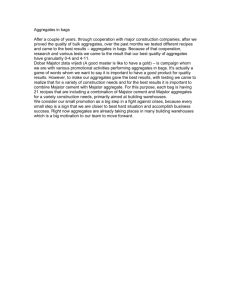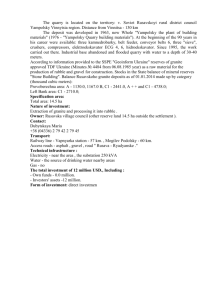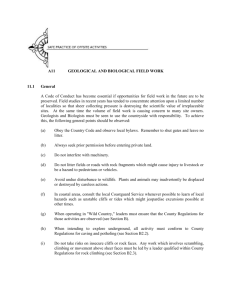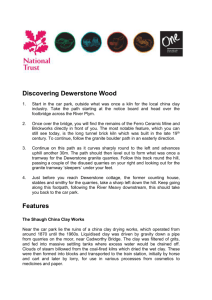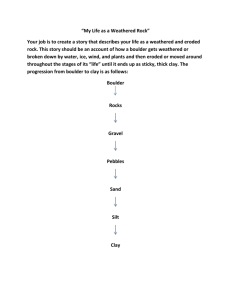Lesson Four - Virtual Quarry
advertisement
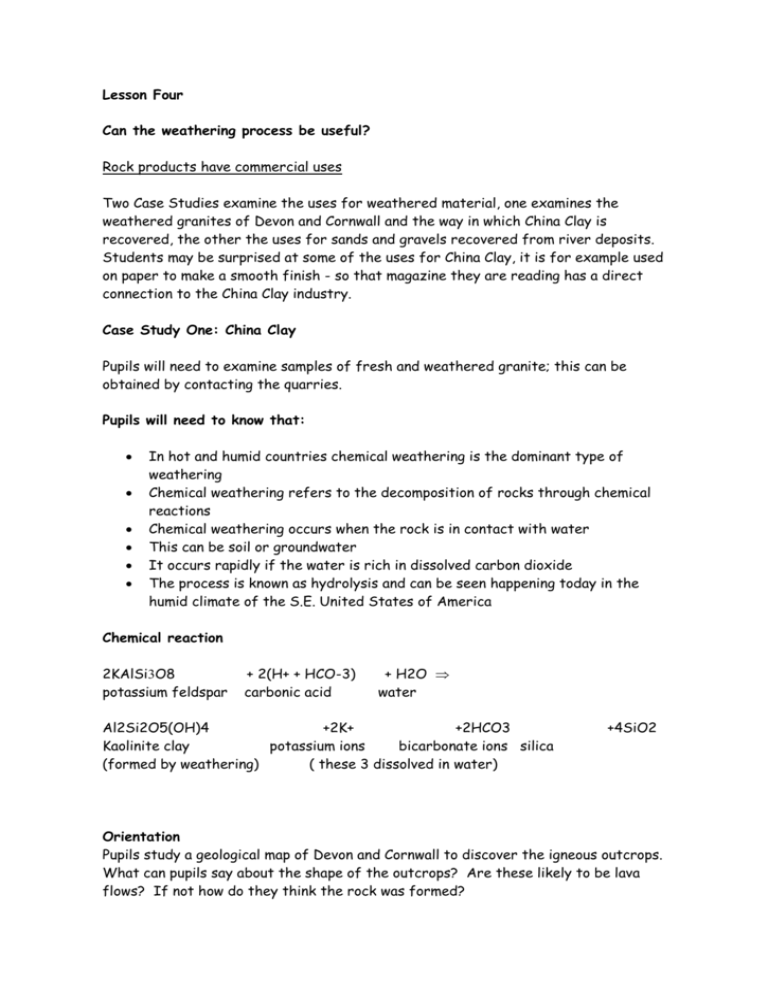
Lesson Four Can the weathering process be useful? Rock products have commercial uses Two Case Studies examine the uses for weathered material, one examines the weathered granites of Devon and Cornwall and the way in which China Clay is recovered, the other the uses for sands and gravels recovered from river deposits. Students may be surprised at some of the uses for China Clay, it is for example used on paper to make a smooth finish - so that magazine they are reading has a direct connection to the China Clay industry. Case Study One: China Clay Pupils will need to examine samples of fresh and weathered granite; this can be obtained by contacting the quarries. Pupils will need to know that: In hot and humid countries chemical weathering is the dominant type of weathering Chemical weathering refers to the decomposition of rocks through chemical reactions Chemical weathering occurs when the rock is in contact with water This can be soil or groundwater It occurs rapidly if the water is rich in dissolved carbon dioxide The process is known as hydrolysis and can be seen happening today in the humid climate of the S.E. United States of America Chemical reaction 2KAlSiO8 potassium feldspar + 2(H+ + HCO-3) carbonic acid + H2O water Al2Si2O5(OH)4 +2K+ +2HCO3 Kaolinite clay potassium ions bicarbonate ions silica (formed by weathering) ( these 3 dissolved in water) +4SiO2 Orientation Pupils study a geological map of Devon and Cornwall to discover the igneous outcrops. What can pupils say about the shape of the outcrops? Are these likely to be lava flows? If not how do they think the rock was formed? Students should use their homework from lesson 1 to help them consider the way in which igneous rocks are formed. If the outcrops in Devon and Cornwall were from lava flows students should expect to see linear outcrop patterns rather than the rounded shapes they see on the map, which are more representative of intrusive formations. Case Study The granites of Devon and Cornwall were formed some 290 – 270 years ago. The formation runs through the South West of England from the Isles of Scilly to Dartmoor. The granites have a typical mineral mix of 30% quartz, 65% feldspars and 5% mica. On the moors tall granite ‘pillars’ can be seen, these are known as Tors. The granites that are exposed at the surface today have been heavily incised; they have been affected by chemical weathering processes. The deep weathering exhibited by the granites is the result of chemical weathering that took place in the Tertiary period (1.8.million years ago) when the climate of the landmass we know as England was very wet and warm. It is believed that superheated waters beneath the surface of the Earth caused chemical reactions to take place, which led to the alteration of feldspar to kaolinite. Kaolinite is a type of clay (silica and aluminia). Images of Tors available at: http://www.richkni.co.uk/dartmoor Quarrying: The clays at St Austell have been quarried since the 1740’s. William Cookworthy exploited the properties of the clay to make ceramics. The clay fires white and so was highly prized. Today kaolinite is used in a wide variety of products, paint, Coca-cola cans, plastic pipes, tennis balls, trainers, car hub caps, porcelain, white lines on the road and for coating the surface of high quality paper. 80% of kaolinite products are exported across the world. In the past there was little regard for the landscape and the way it was affected by the extraction of kaolinite but that is not the case today. Information on the restoration of china clay quarries can be obtained from the Dartmoor Society. Students need to know that: The clays are removed from the weathered granite by high-pressure hoses. This works the loose material free and it is washed into a pit. From there it is pumped into a series of tanks and the quartz and mica are left to settle Once this has happened the clay is separated out and left to settle and dry. The process leaves large holes in the landscape and a great deal of waste. It is estimated that for every tonne of clay there will be 7 tonnes of waste. Case Study cont. Sustainability: Spoil tips are being “mined” for secondary aggregates including china clay sand which is used in the manufacture of concrete. Quarries today take the issues of sustainability very seriously and are busy reducing the amount of material left as waste. There is more information on primary and secondary aggregates along with the sustainable use of aggregates with the second Case Study, Sands and Gravels. Biodiversity: Disused china clay works provide a habitat for rare plants. In the old quarry at West Penwith the Western Rustwort is growing freely. This plant is only found in West Cornwall and was thought to be in serious decline. Homework Many species of plants and animals in the United Kingdom are in decline because of the spread of housing. Write an article for a newspaper explaining the role both working and restored quarries are playing in providing habitats for threatened species. Case Study Two: River Sands and Gravels Pupils will need to examine samples of sand and gravel, which can be obtained by contacting local quarries or from local quarry products associates. Students need to know that: Weathered rock is transported by water in streams, rivers and estuaries As the rock is moved in the water it is gradually broken down into smaller pieces As the transportation of the material continues the pieces become rounder Sediments can be moved in rivers or the melt water of glaciers or by wind. These are all fluids and the velocity at which they flow determines the size of the weathered material that can be moved and how far it can be moved. As the energy of the fluid decreases the weathered material will be deposited, the heaviest is dropped first and then with ever decreasing velocity so progressively finer material is deposited Boulders, cobbles, sands and gravels are the names given to those sediments by the quarrying industry A cobble is a different size to a boulder, sand a different size to gravel Students can use the Internet to discover the size range for each of the materials mentioned. Aggregates Aggregates is a word used to cover lots of different types of material used by the construction industry. Sands and gravels, crushed rock even solid blocks of rock used on beaches as flood defences are aggregates. Aggregates are divided into different groups. Natural: Natural aggregates are sub divided into primary or secondary aggregates. Primary aggregates are sands, gravels and rocks quarried directly from the ground. Secondary aggregates are formed form the waste products of the primary extraction process. Made/Manufactured: This group includes fly ash from coal fired power stations and the slag which forms as part of the steel making process Recycled: When a building is demolished the bricks can be crushed to use as aggregate rather than being buried in a landfill site. Any concrete removed can be crushed and used in the same way. Other material can also be recycled and used as aggregates – tyres can be chipped or glass can be made into pellets to be used in road surfaces instead of using only primary aggregates. Everyone relies on aggregates in their daily lives, for example it takes about 50 tonnes of aggregate to build a small family home, the United Kingdom as a whole uses about 100 million tonnes of aggregate every year. The quarrying industry is looking at ways to ensure they operate in a sustainable way. Students need to know that: Sustainable operation means to conserve as much as possible of the United Kingdoms aggregate stock without using primary resources from other countries or using other natural resources as primary building materials. We should use more secondary or recycled aggregate. We should ensure we use the primary aggregates in the best possible way, for example not used crushed rock if a secondary aggregate would be suitable for the task. Students need to think about: The properties of the materials used as aggregates Are they hard wearing and durable? How will they weather? Students need to understand that these processes do not stop just because the rock is being used in a building. How chemically reactive is the material? Students should also consider: The impact of the quarrying itself n the surrounding area Sand and gravel quarries operate for about 10 years, rock quarries in excess of 40 years Employment in the industry www.qpa.org/quarry.htm provides an interactive map of the United Kingdom; students can click on regions to discover how much aggregate is quarried in that region and how many people are employed in the aggregate industry in each region. Students could consider the impact of quarrying in their own region or produce graphs to illustrate the amount of aggregate removed or the number of people employed by region Activity and Homework Little Paxton Quarry: Planning for a Sustainable Future. Sands and gravels from the river terraces along the River Great Ouse in Cambridgeshire at Little Paxton have been used by people living in the area for over 4000 years in the construction of their settlements. By the nineteenth century gravel was being extracted on a commercial scale for the construction of houses and roads. When the Second World War began gravel from this area was used in the construction of runways for the Royal Air Force. Since then the area has provided gravel fro housing, by passes and other major construction projects. The current owners of the site have permission to extract sand and gravel until 2006, in 2003 they submitted a planning application to extend the life of the quarry by a further 13 years in order to meet aggregate needs for the area. Teachers may find it useful to read the Technical Summary (7 pages) prepared by Cambridgeshire County Council in advance of the planning decision. http://www.cambridgeshire.gov.uk/NR/rdonlyres/3B7ED936-1530-4D31-BDIC866D8B43B74B/O/little_paxton_NTS1.pdf Two publications in particular should be used by the students. Bardon Quarries have produced a leaflet entitled little Paxton Quarry: planning for a sustainable future. This can be downloaded from http://www.paxton-pits.org.uk/quarry/AI_leaflet.pdf There is also a leaflet outlining the history of gravel extraction in this area with links showing community and conservation awards won by te aggregates industry over the last 5 years http://www.paxton-pits.org.uk/quarry/ The Friends of Paxton Pits have produced their own response to the request for extended working. This can be downloaded from http://www.paxton-pits.org.uk/quarry/extension/ There are links from this site to other useful documents and maps. Activity Should the extension to the quarry be granted? Students should be divided into 2 groups, 1 group to represent the Quarry managers and 1 group The Friends of Paxton Pits. Students read all of the printed material available for students. Each large group is now divided into smaller sub sets Working on a large piece of paper each set has a storming session to identify points they think are really important for the group they are representing i.e. Friends or Quarry Owners The small sets come back together and share their ideas Using a large piece of paper pinned up on the wall each group sets out agreed points in their argument Teacher input will be needed throughout to ensure students understand the task, remain focused, are able to discuss without resorting to argument! Students need to consider the UK’s need for aggregates, local employment needs (employed by the Quarry or by the tourist industry), the use of alternatives, the after use of the site. Students imagine they are to give a short speech at an open meeting to decide if permission should be granted to extend the quarry. They remain in role i.e. Friend or Quarry Owners Students use the ideas gathered by the whole group to help them plan the speech Speech written up as homework activity

